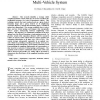Free Online Productivity Tools
i2Speak
i2Symbol
i2OCR
iTex2Img
iWeb2Print
iWeb2Shot
i2Type
iPdf2Split
iPdf2Merge
i2Bopomofo
i2Arabic
i2Style
i2Image
i2PDF
iLatex2Rtf
Sci2ools
CIRA
2007
IEEE
2007
IEEE
Compliant Formation Control of a Multi-Vehicle System
— This research identifies a strategy called compliant formation control, which may be used to coordinate the navigational structure of a team of autonomous vehicles. This technique controls the team’s motion based on a given, desired formation shape and a given, desired set of neighboring separation distances, wherein the formation shape is considered general two-dimensional. The strategy establishes how to select, place, and use virtual springs and dampers that conceptually "force" proper interspacing between neighboring team members. The objective is to continuously maintain, in the most optimal way, the desired formation as team motion proceeds. In practice, actual robot separation distances will be measured relative to smarter, leader robots that have known position and orientation information at all times (e.g., GPS or INS). The control strategy subsequently commands, in an optimal way, each vehicle by providing a heading and velocity necessary to maintain the desir...
| Added | 02 Jun 2010 |
| Updated | 02 Jun 2010 |
| Type | Conference |
| Year | 2007 |
| Where | CIRA |
| Authors | Erica Z. MacArthur, Carl D. Crane III |
Comments (0)

